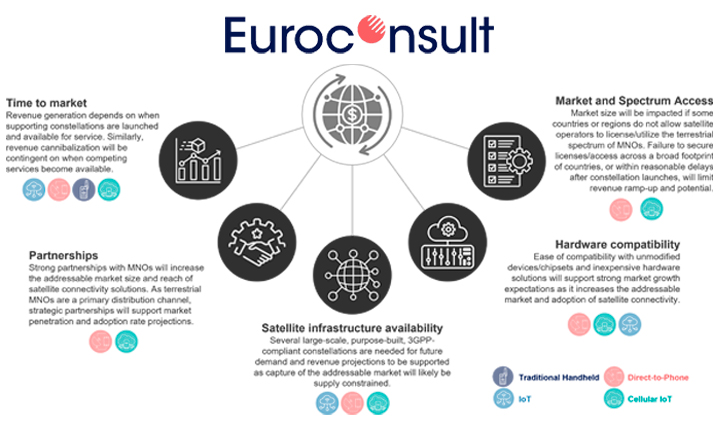 From Euroconsult’s “Prospects for Direct to Handheld and IoT Markets, 8th Edition,” Nov. 2023. (Source: Euroconsult)
From Euroconsult’s “Prospects for Direct to Handheld and IoT Markets, 8th Edition,” Nov. 2023. (Source: Euroconsult)
About the graphic:
Satellite direct-to-device connectivity is rapidly growing due to several factors. Advancements in the 3rd Generation Partnership Project (3GPP) standards, specifically Release 17, are paving the way for the integration of terrestrial and NTN connectivity. Continuous improvements in technology are increasing global satellite capacity and overall supply. Additionally, enhanced device capabilities are contributing to the accelerated adoption of satellite services.
Euroconsult’s “Prospects for Direct to Handheld and IoT Markets” report asserts that traditional handheld phone users will decline by nearly half, while the direct-to-phone market will see a rising user count by 2032 to around 130 million. The addressable market for direct-to-phone services is projected to remain stable between 2022 and 2032, moving from approximately 2 billion average monthly users to 1.9 billion, with the decline in the unconnected user base being starker than the growth in the total out-of-coverage user base.
IoT devices are expected to triple over the coming decade, largely due to the increased accessibility of satellite IoT solutions offered by new market entrants. This market is forecast to generate over $1.5 billion annually by 2032. The current satellite IoT market is dominated by the Transport and Logistics sector, requiring seamless connectivity to support the mobility of connected devices, and Natural Resources and Infrastructure, relying on ubiquitous coverage in remote regions.
Over the next 2-5 years, a market for satellite cellular IoT connectivity, a niche subset of the cellular IoT sector, is expected to emerge, enabling hybrid solutions via in-market unmodified IoT devices, largely due to ease of implementation. This niche market is expected to address over 10.6 million cellular IoT devices by 2032.
Despite the strong prospects for the direct-to-handheld and IoT markets, success will be largely influenced by external factors, particularly securing spectrum rights and overcoming regulatory barriers, and internal forces, including funding initiatives to support planned satellite infrastructure and commitments from MNOs. Most importantly, affordability of services and willingness to pay will dictate market success as these consumer-facing satellite connectivity solutions operate in a very cost-sensitive market.
About the author:
Sumaiya Najarali is a Senior Consultant at Euroconsult, based in Montreal. She actively contributes to consulting studies and market intelligence reports within the satellite communications sector. Sumaiya is the editor of Euroconsult’s “Prospects for Direct to Handheld and IoT Markets” report and has made key contributions to Euroconsult’s report on “Satellite Connectivity and Video Market, Universal Broadband Access (UBA) and Prospects for Maritime Satellite Communications.”
About the report:
“Prospects for Direct to Handheld and IoT Markets” (eighth edition) is a comprehensive and detailed market analysis covering three critical satellite communication market segments: traditional handheld phones, direct-to-phone connectivity, and IoT. It includes market developments, major applications, equipment solutions, as well as growth drivers and challenges of each market.
